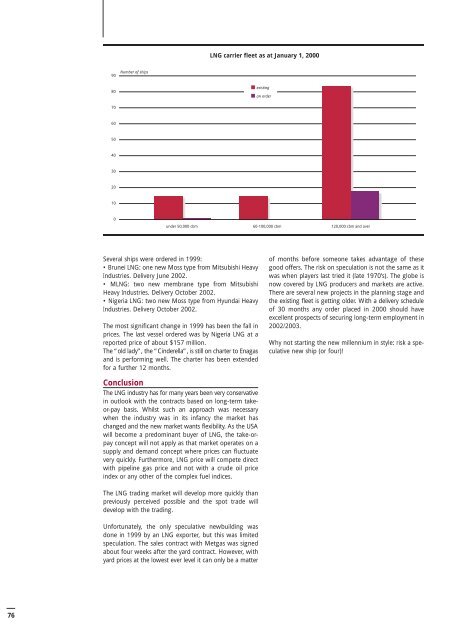You also want an ePaper? Increase the reach of your titles
YUMPU automatically turns print PDFs into web optimized ePapers that Google loves.
76<br />
90<br />
80<br />
70<br />
60<br />
50<br />
40<br />
30<br />
20<br />
10<br />
0<br />
Number of ships<br />
Several ships were ordered in 1999:<br />
• Brunei LNG: one new Moss type from Mitsubishi Heavy<br />
Industries. Delivery June 2002.<br />
• MLNG: two new membrane type from Mitsubishi<br />
Heavy Industries. Delivery Oc<strong>to</strong>ber 2002.<br />
• Nigeria LNG: two new Moss type from Hyundai Heavy<br />
Industries. Delivery Oc<strong>to</strong>ber 2002.<br />
The most significant change in 1999 has been the fall in<br />
prices. The last vessel ordered was by Nigeria LNG at a<br />
reported price of about $157 million.<br />
The “old lady”, the “Cinderella”, is still on charter <strong>to</strong> Enagas<br />
and is performing well. The charter has been extended<br />
for a further 12 months.<br />
Conclusion<br />
The LNG industry has for many years been very conservative<br />
in outlook with the contracts based on long-term takeor-pay<br />
basis. Whilst such an approach was necessary<br />
when the industry was in its infancy the market has<br />
changed and the new market wants flexibility. As the USA<br />
will become a predominant buyer of LNG, the take-orpay<br />
concept will not apply as that market operates on a<br />
supply and demand concept where prices can fluctuate<br />
very quickly. Furthermore, LNG price will compete direct<br />
with pipeline gas price and not with a crude oil price<br />
index or any other of the complex fuel indices.<br />
The LNG trading market will develop more quickly than<br />
previously perceived possible and the spot trade will<br />
develop with the trading.<br />
Unfortunately, the only speculative newbuilding was<br />
done in 1999 by an LNG exporter, but this was limited<br />
speculation. The sales contract with Metgas was signed<br />
about four weeks after the yard contract. However, with<br />
yard prices at the lowest ever level it can only be a matter<br />
LNG carrier fleet as at January 1, 2000<br />
existing<br />
on order<br />
under 50,000 cbm 60-100,000 cbm 120,000 cbm and over<br />
of months before someone takes advantage of these<br />
good offers. The risk on speculation is not the same as it<br />
was when players last tried it (late 1970’s). The globe is<br />
now covered by LNG producers and markets are active.<br />
There are several new projects in the planning stage and<br />
the existing fleet is getting older. With a delivery schedule<br />
of 30 months any order placed in 2000 should have<br />
excellent prospects of securing long-term employment in<br />
2002/2003.<br />
Why not starting the new millennium in style: risk a speculative<br />
new ship (or four)!


